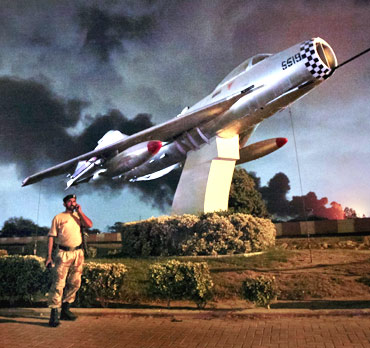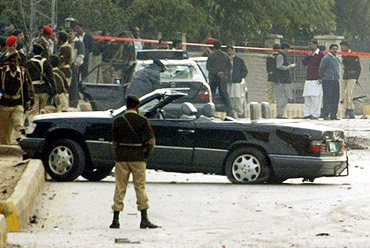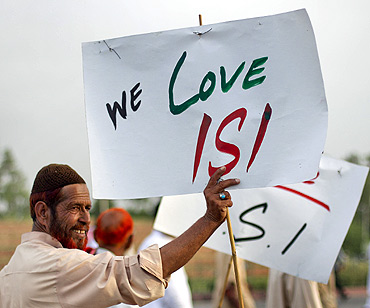
The recent attacks against military installations in Pakistan, including the recent attack on the Mehran naval base, point to the role of some insiders. However, renowned Pakistani commentator Amir Mir says the jihadist elements with the military are sprinkled on among the lower-rung.
The May 30 arrest of a former Special Services Group commando of the Pakistan Navy in connection with the May 22 fidayeen attack on PNS Mehran naval base in the port city of Karachi speaks volumes about the growing penetration of the Pakistani armed forces by jehadi elements who are being aided from within in the ongoing terrorist campaign against Pakistan.
The dangerous development has set alarm bells ringing for the Pakistani military leadership, which is already under sharp criticism for the May 2 raid by American commandos which killed Osama bin Laden in Abbottabad and subsequent terror attacks on highly sensitive and well-guarded military installations in various parts of the country.
The infiltration of the Karachi naval base by the Al Qaeda and Taliban-linked elements has only given credence to some earlier reports that the audacious assault could not have been possible without 'inside help'.
...

The Pakistani authorities have arrested from Lahore a former commando of the Pakistan Navy, Kamran Ahmed, and his younger brother, Zaman Ahmed, for allegedly aiding the fidayeen attackers on May 22.
Kamran, who had joined the navy in 1993 and was trained as a Special Services Group commando, has reportedly been detained on charges of providing maps of the Mehran naval base to the attackers.
He had served at the Iqbal naval base in Karachi till 1997 and was later transferred to the Mehran base where he had served till 2003, before being court-martialled by his institution and terminated from service in 2003 for assaulting a senior officer. The military court had further declared Kamran unfit for the job because of his extremist views.
However, Kamran is not the only navy officer to have been arrested for his links with jehadis. Another Pakistani marine commando from the Waziristan tribal region, who had been posted at the Mehran naval airbase, was arrested in January 2011 for his alleged links with militants.
During interrogation, he disclosed that Al Qaeda and Taliban-linked militants had plans to target some key naval installations, including oil depots and power grid stations.
Interestingly, the arrested commando was a member of the Mehsud tribe from the Federally Administered Tribal Areas of Waziristan, which has produced some top Taliban leaders like the Tehrik-e-Taliban Pakistan founder Baitullah Mehsud, Qari Hussain Mehsud and Hakimullah Mehsud, the incumbent TTP chief.

The responsibility for the naval base attack has already been claimed by the banned TTP, saying it was carried out to avenge the killing of Al Qaeda chief Osama bin Laden.
It has also transpired in subsequent investigations that the naval base attack was masterminded by Al Qaeda's interim chief Saif al Adal whereas the operational planning of the assault was given final touches by Al Qaeda's chief strategist Ilyas Kashmiri, with the backing of the Pakistani Taliban elements.
While Saif is an Egyptian national and a former colonel of the armed forces, Ilyas Kashmiri is a Pakistani national who had been a part of the Special Services Group of the Pakistan Army.
However, the most astonishing piece of information about the Karachi naval base attack came from a senior Pakistani journalist, Syed Saleem Shehzad, in his May 28 report titled "Al Qaeda had warned of Pakistani strike" (published by the Hong-Kong-based Asia Times Online).
Saleem was abducted under mysterious circumstances from Islamabad a day after his report had appeared and subsequently killed on May 31 when his dead body was discovered.
According to his account of the naval base attack, it was carried out by Al Qaeda after talks had failed between the navy top brass and the international terrorist outfit over the release of naval officials who had been arrested on suspicion of Al Qaeda links.
The deceased Pakistani journalist had claimed that the attackers were from 313 Brigade, which is the operational arm of Al Qaeda and has carried out some lethal terror attacks in various parts of Pakistan.
"Three bomb attacks targeting navy buses in April this year, which killed nine people, were in fact warning shots for navy officials to accept Al Qaeda's demands over the detained suspects. The May 2 killing of Osama bin Laden spurred Al Qaeda groups into developing a consensus for the naval base attack in Karachi, in part as revenge for the killing of their leader and also to deal a severe blow to Pakistan's surveillance capacity against the Indian Navy".
The news report further stated that the deeper underlying motive (behind the navy attack) was a reaction to massive internal crackdowns on Al Qaeda affiliates within the Pakistan Navy.
It added: "Several weeks ago, naval intelligence traced an al-Qaeda cell operating inside several navy bases in Karachi. When some messages were intercepted hinting at attacks on visiting US officials, the authorities had good reason to take action. After careful evaluation, at least ten people -- mostly from the lower cadre (of the navy) -- were arrested in a series of operations. That was the beginning of huge trouble. However, before proper interrogation could begin, the in charge of the investigation received direct threats from militants, making it clear that they knew where the men were being detained. The detainees were promptly moved to a safer place, but the threats continued".

Syed Saleem Shehzad went on to state in his report: "Officials involved in the case believe the militants feared that interrogation would lead to the arrest of more of their loyalists in the navy.
Therefore, they warned that if those detained were not released, naval installations would be attacked. Therefore, a senior-level naval conference was called at which an intelligence official insisted that the matter be handled with great care; otherwise the consequences could be disastrous. Everybody present agreed, and it was decided to open a line of communication with Al Qaeda."
"Abdul Samad Mansoori, a former student union activist and now part of 313 Brigade was approached and talks begun. Al Qaeda demanded the immediate release of the officials without further interrogation. This was rejected. The detainees were allowed to speak to their families and were well treated, but officials were desperate to interrogate them fully to get an idea of the strength of Al Qaeda's penetration.
"The militants were told that once interrogation was completed, the men would be discharged from the service and freed. Al Qaeda rejected these terms and expressed its displeasure with the bomb attacks on the navy buses in April. These incidents pointed to more than the one Al Qaeda cell intelligence had tracked in the Pakistan Navy".
After Osama bin Laden was killed by Americans in Abbottabad, the militants decided that the time was ripe for a major action. Within a week, insiders at the Mehran base provided maps, pictures of different exit and entry routes taken in daylight and at night, the location of hangers and details of likely reaction from external security forces. As a result, the fidayeen attackers were able to enter the heavily guarded facility where one group targeted the aircraft, a second group took on the first strike force and a third finally escaped with the others providing covering fire.
Those who stayed behind fought with hundreds of the security forces personnel for about 16-hour and died eventually after having destroyed two precious P-3C Orion aircraft of the Pakistan Navy, worth millions.
Everything about the assault, from the methodical tactics to the targeting of Orion surveillance aircrafts suggested that the attackers had used inside information.

To tell the truth, the spectre of Islamist infiltration has haunted the armed forces of Pakistan for decades. The creeping coup of conservatism in the armed forces is a legacy of the third military dictator, General Zia-ul-Haq, under whose command the state policies were centered on Islam; religious sermons by fanatic mullahs in military units were encouraged and even Tableeghi Jamaat members were allowed to preach in the garrisons at will.
This drift within the armed forces was first revealed during Benazir Bhutto's second tenure as prime minister in 1995, when a group of senior army officers headed by a major general was busted planning to topple the government and to eliminate the existing army leadership, with the prime aim of enforcing Islamic Shariah in the country.
The subsequent arrest of dozens of commissioned and non-commissioned officers of the army and the air force in connection with the December 2003 suicide attacks targeting (the president) Pervez Musharraf's cavalcade in Rawalpindi did not, consequently, come as a great surprise to many.
And it probably did not surprise the military leadership that Al Qaeda and Taliban-linked militants had penetrated the Pakistan army and air force units to preach their brand of jihad and recruit personnel to assassinate none other than their own army chief.
After surviving twin assassination attempts, Musharraf had ordered the purging of known Islamists from superior ranks of the armed forces.
In January 2005, almost a year later, after court martial proceedings, a military court headed by Lieutenant-Colonel Sultan Noor Ali Khan of 96 Medium Air Defence Regiment, sentenced three air force officers to terms ranging from two to nine years for alleged links with the Jaish-e-Mohammad led by Maulana Masood Azhar.
Three months later, in March 2005, the trial court handed down a death sentence (in absentia) to another accused in the conspiracy to assassinate Musharraf, Naik Arshad Mahmood of the Special Services Group of the army and others, including Havaldar Mohammad Younis of the 98 Air Defence Regiment, who was awarded 10 years hard labour, and Lance Naik Zafar Iqbal Dogar of the SSG, who abandoned the mission halfway and became a key state witness.

Six months later, on September 18, 2005, yet another military trial court sentenced Major Adil Qudoos to 10 years in prison, Colonel Abdul Ghaffar to three years and Colonel Khalid Abbasi to six months. Major Attaullah, Major Faraz and Captain Zafar were dismissed from service.
However, in an unprecedented move, never heard in the Pakistan Army, Abdul Islam Siddiqui, an army soldier, was executed on August 20, 2005 after being tried in a closed-door court martial, headed by a major general. The 35-year-old Siddiqui was charged with pressing the button of the remote control device which caused an explosion targeting Musharraf in Rawalpindi on December 14, 2003.
The execution was clearly meant to give a clear message to the Islamists in uniform that they would be dealt with an iron hand. The charges against Siddiqui included abetting mutiny against the army chief and attempting to persuade "a person in the military" to rebel against the government.
Siddiqui was also charged with receiving terrorism training in Bhimber (Jammu Kashmir) at a Jaish-e-Mohammad-run training camp. But his family members insisted that Siddiqui was actually arrested in South Waziristan after he had refused to fight against local tribes suspected of having links to the Taliban and Al Qaeda.

The South Waziristan military operation had turned out to be the biggest dent in the Pakistani Army discipline as several units reportedly declined to be posted in South Waziristan and dozens of troops refused to continue the fight against tribes.
The development literally shocked the military high-command which had to recall most of the troops from the frontline.
These developments clearly indicated that conflicting ideologies have caused fissures in the Pakistan armed forces, pitting Islamists against reformists.
The split actually sharpened in the aftermath of the 9/11 terror attacks because of Musharraf's attempts under American pressure to give his army a liberal outlook, acceptable to the United States.
However, several years later, with Musharraf gone and bin Laden having already been killed, there are strong indications to suggest that Islamic extremists are still sprinkled within the lower ranks of the Pakistani armed forces and have been involved in several deadly attacks in the recent past, targeting vital military installations.
One such attack targeting the General Headquarters of the Pakistan Army was carried out in October 2009 in Rawalpindi by a group of fidayeen attackers, led by Mohammad Aqeel alias Dr Usman, who had served as a nursing assistant in the Army Medical Corps, Rawalpindi before abandoning the army in 2004 to join hands with Ilyas Kashmiri, who heads Brigade 313.